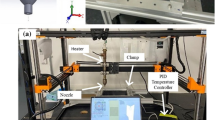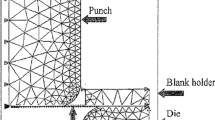Abstract
As a promising technology, sheet metal flexible forming processes have been increasingly employed for different industrial applications. This technology is characterized by its simplicity, versatility of process and feasibility of prototyping; thus, it seems suitable for sheet forming at micro-scale. This paper presents an experimental investigation and numerical simulation of micro-deep drawing processes of stainless steel 304 foils utilizing soft dies made of polyurethane rubber materials with different hardness. The forming system developed in this work consists mainly of soft die, rigid punch, adjustment ring and blankholder. The blankholder is moveable part and supported by a compressive spring by which the required holding force can be controlled. The new technique proposed in this work involves adopting an initial gap (positive or negative) between the blankholder and adjustment ring, which allows for the metal sheet to form initially only against the holding spring force. The key process parameters rubber type, rubber-die dimensions, blank diameter and geometrical scaling factor, related to the drawing process are investigated in detail. The feasibility of the process is firstly investigated through FE simulations using the commercial software Abaqus/Standard. A serious of micro-deep drawing experiments, conducted using a special set up precisely developed to satisfy the requirements of the proposed technique, is conducted for verifying the numerical simulations. The results indicate the capability of the proposed technique for producing micro-cups with high quality and low production cost.
Similar content being viewed by others
References
Liu Y, Hua L, Lan J, Wei X (2010) Studies of the deformation styles of the rubber-pad forming process used for manufacturing metallic bipolar plates. J Power Sources 195:8177–8184
Geiger M, Kleiner M, Eckstein R, Tiesler N, Engel U (2001) Microforming. CIRP Ann Manuf Technol 20:445–462
Thiruvarudchelvan S (2002) The potential role of flexible tools in metal forming. J Mater Process Technol 122:293–300
Peng L, Liu D, Hu P, Lai X, Ni J (2010) Fabrication of metallic bipolar plates for proton exchange membrane fuel cell by flexible forming process-numerical simulations and experiments. J Fuel Cell Sci Technol 7:0310091–0310099
Peng L, Hu P, Lai X, Mei D, Ni J (2009) Investigation of micro/meso sheet soft punch stamping process—simulation and experiments. Mater Des 30:783–790
Quadrini F, Santo L, Anna E (2010) Flexible forming of thin aluminium alloy sheets. Int J Mod Manuf Technol II:79–84
Husnu Dirikolu M, Akdemir E (2004) Computer aided modelling of flexible forming process. J Mater Process Technol 148:376–381
Wang X, Du D, Zhang H, Shen Z, Liu H, Zhou J, Liu H, Hu Y, Gu C (2013) Investigation of microscale laser dynamic flexible forming process-simulation and experiments. Int J Mach Tools Manuf 67:8–17
B Nagarajan, S Castagne, Z Wang, H. Y. Zheng and K Nadarajan (2015) Influence of plastic deformation in flexible pad laser shock forming – experimental and numerical analysis. International Journal of Material Forming 1–15.
Jeong M-G, Jin C-K, Hwang G-W, Kang C-G (2014) Formability evaluation of stainless steel bipolar plate considering draft angle of die and process parameters by rubber forming. Int J Precis Eng Manuf 15:913–919
Vollertsen F, Hu Z, Niehoff H, Schulze H, Theiler C (2004) State of the art in micro forming and investigations into micro deep drawing. J Mater Process Technol 151:70–79
Vollertsen F (2008) Categories of size effects. Prod Eng Res Dev 2:377–383
American Society for Testing and Materials (ASTM) (2007) E8 Standard test methods of tension testing of metallic materials. Annual ASTM Standards 99
G L. Bradley, P C. Chang and A W. Taylor (1998) Determination of ultimate capacity of elastomeric bearings under axial loading. Report to United State Department of Commerce, National Institute of Standards and Technology (NIST)
Le Port A, Toussaint F, Arrieux R (2009) Finite element study and sensitive analysis of the deep drawing formability of commercially pure titanium. Int J Mater Form 2:121–129
Hai DV, Itoh S, Sakai T, Kamado S, Kojima Y (2008) Experimentally and numerical study on deep drawing process for magnesium alloy sheet at elevated temperatures. Mater Trans 49:1101–1106
L Crocker and B Duncan (2001) Measurement methods for obtaining volumetric coefficients for hyperelastic modelling of flexible adhesives. Performance of Adhesive Joints Programme, Project PAJex2 - Flexible Adhesives, PAJex2 Report No 3
J-T Gau, S Teegala, K-M Huang, T-J Hsiao and B-T Lin (2013) Using micro deep drawing with ironing stages to form stainless steel 304 micro cups. http://www.sciencedirect.com/science/article/pii/S1526612513000236
Author information
Authors and Affiliations
Corresponding author
Rights and permissions
About this article
Cite this article
Irthiea, I.K., Green, G. Evaluation of micro deep drawing technique using soft die-simulation and experiments. Int J Adv Manuf Technol 89, 2363–2374 (2017). https://doi.org/10.1007/s00170-016-9167-2
Received:
Accepted:
Published:
Issue Date:
DOI: https://doi.org/10.1007/s00170-016-9167-2




